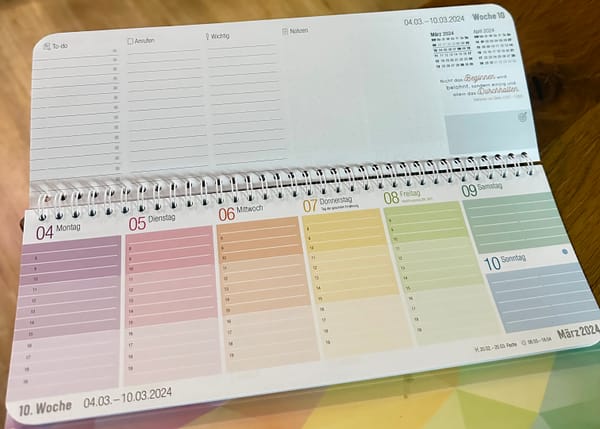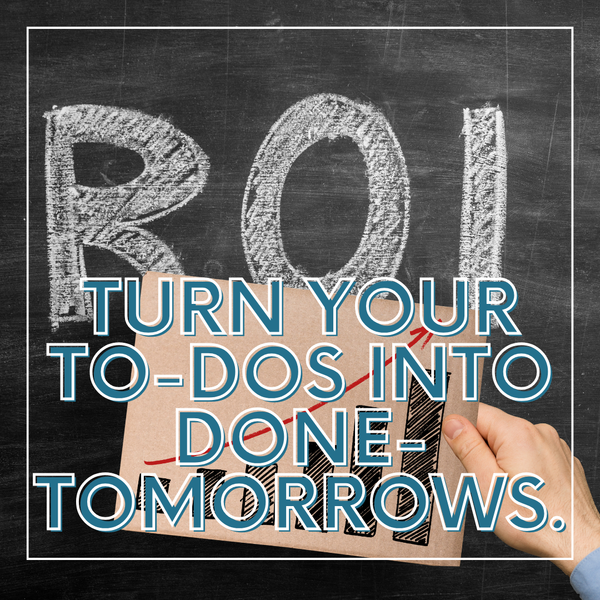Diligent Sunday #24: Escape your Busyness Hamster Wheel with the 3x3 Time Mastery Framework
Attain work-life balance and accomplish your goals using my 3x3 Time Mastery Framework. Learn how to find clarity, hone focus, increase effectiveness, and escape the busyness hamster wheel for a more satisfied and productive life.

Introduction
Hello everyone,
Another week has passed, and 69.2% of the year is over. I hope you have had the kind of week that suits your taste.
Personally, I like weeks filled with work and progress but allow enough space to invest in health, family and creative side businesses. Too little workload, and we might quickly feel stagnant and unsatisfied. Too much workload, and we feel overwhelmed and frustrated as the balance goes off track.
In a corporate setting and our own businesses, the period between autumn and Christmas can be a dangerous time when we risk getting caught in a hamster wheel of busyness. People return from their holidays and remember all the goals and tasks that need finishing before the end of the year. Markets and firms become more active, leading to a dynamic environment that leads to more tasks for everyone, whether you're a business owner or working for a corporation.
If you follow this dynamic, you could quickly find yourself burdened with not just meaningful tasks but non-essential ones - at least for your own agenda. Tasks that may appear "productive" but don't progress your own goals and responsibilities.
You can avoid this by following the 3x3 Time Mastery Framework, which I'd like to introduce in this Diligent Sunday Issue.
I hope you find it useful!
Best regards,
-- Martin Weitzel (LinkedIn, Email, Website)

Saying yes to everything is the same as saying no to your own well-being
Why do you get into the busyness hamster wheel?
Three traps lead you into the busyness hamster wheel:
- Lack of clarity: You say yes to everything thrown your way, as you have no clarity about your own agenda.
- Lack of focus: You have clear objectives, but they are broad, and there are many good opportunities to seize.
- Lack of effectiveness: You don't choose the simplest and most direct ways to complete your tasks.
Each of these traps can lead you into the business hamster wheel. Suppose you are suffering from all three problems. In that case, you need to be especially careful - you are on the fastest route to burnout, which may already manifest through a regular feeling of being overwhelmed.
The underlying misconception, particularly among the most ambitious individuals, is the feeling that they need to fill their limited lifetime with work down to the last drop to avoid wasting time. This is understandable, as no one wants to look back on missed potential with regret at the end of their life.
However, the misconception lies in the definition of work. Those who optimise their time to fill it with work volume naturally choose tasks that are easily completed yet take up a lot of time. For example, you are dealing with emails and notifications or discussing a problem in meetings with four other colleagues without directly considering solving it alone. A meeting can quickly fill an hour of your week with "work". But is it an effective way to get closer to your goal? Often, it's not.
Only those who sharply focus their mindset on working on the right tasks (even if they are hard and strenuous) and carry them out correctly will succeed in escaping the business hamster wheel. Only they all manage to allocate time to all areas of life in a balanced and effective manner.
Work is not a matter of volume, but a matter of value.

Your calendar is the blueprint of your life; design it wisely.
How to Escape Your Never-Ending Cycle of Busyness for Good
Many people struggle to balance their personal and work lives. It feels like you're always running but never getting anywhere. To help you break free from your busyness hamster wheel, here's the 3x3 Time Mastery Framework:
I. Clarity
Clarity in thought leads to serenity in action.
- Find Serenity: Change your thoughts about work, time, progress and how you present yourself to others. Find alignment of these terms with your self-chosen life responsibilities. This personal agenda will help you not to see work as work but as part of your life, which will help you feel more relaxed and authentic.
- Overcome Limiting Beliefs: Explore different paths to success. Recognise the absurdity in societal and corporate norms. Challenge and then remove the limits you've set for yourself.
- Balance Your Time: Show me your calendar, and I'll tell you your future. See the problem in your previous time allocation and create an ideal daily routine that allows your time to be spent evenly across different parts of your life.
II. Focus
Less is more.
- Sort Your Priorities: Picking tasks off a list isn't enough. Make sure what you do helps you reach your bigger goals. In other words, ensure you're climbing the ladder leaning against the right wall.
- Focus on One Thing: With so many (actually good) choices out there, it's best to concentrate your energy on just one thing. You won't do anything well if you try to do too much. Don’t spread yourself thin.
- Cut Out Distractions: Keep your attention sharp, and don't let anything sidetrack you. Control what enters your thoughts. Learn how to get yourself into a flow mode. Clear thinking is the first step to getting things done.
III. Impact
Simplicity is power.
- Solve Problems by Cutting Back: Instead of adding more things to fix a problem, see if removing something improves it. Adopt this mindset in your communication, personal order, possessions and finances.
- Use Habits, Delegation and Leverage: Make some tasks automatic to save mental energy. Avoid non-essential tasks, delegate where possible, and apply leverage to multiply your output.
- Use the 80/20 Rule: Striving for perfection will slow you down. Focus on the most crucial 20% of the work, which yields 80% of the results.
Your goal isn't just to manage your time better; it's to change how you think about time, work, and even yourself. This framework isn't just a list—it's your first step to a brand-new, refined life design.


Perfection is the enemy of progress; aim for the vital 20%
What can you do today to start your time mastery journey?
Do you feel overwhelmed when you think about all the tasks for the next few days and weeks? Do you feel you lack a guiding thread for your decisions and actions? Then start with the following practical tools from the 3x3 Time Mastery Framework to find a starting point for your journey to becoming a master of your schedule:
Finding Clarity
Use the Hour Glass Template and mark the weeks of life that have already passed as black. Use the comment column to list your significant past milestones and achievements.
Look to the future: What are your subsequent major achievements and milestones? When do you want to hit these? Write only one milestone per line. If you have several goals in one timeline, you need to prioritise. You may find everything meaningful, but perhaps urgency creates a sequence. Also, some objectives might build on each other. Use this for sequencing as well.
Further down, or later in your life, describe your milestones more broadly. The milestones for your next 2-3 years should be crystal clear. As each line represents half a year of your life, you should have 4-6 milestones during this time.
Effectiveness is not just about doing more, but often about doing less.

Creating Focus
If you're like most people, you could write 12-20 goals in a brainstorming session without any problems. A few are for work, your family, your free time, your health, your lifestyle, your passions, your finances and your side business. It all adds up quickly.
Strategic Focus
The only problem is that, realistically, you can only have one primary focus for a defined period and two further goals in other areas of life in which you also want to make progress. The objectives of your other areas of life typically have to pause during this time.
For example, my priority for my six-month sprint is to develop my side business. Two additional goals in other areas are improving my appearance and health through exercise and making progress in starting my family. I'm not currently focusing on other goals, like my career or investments. This does not mean that I'm doing nothing and not investing time there, but rather that I'm not using willpower to grow there. My willpower only flows to my primary side business priority and my two secondary objectives, health and family, because the changes need willpower.
Now, look at your Hourglass exercise. If you look at your desired milestones, can you tell your top priority and secondary goals?
In the economy of attention, focus is your currency.

Tactical Focus
You now have your strategic focus. Next, you need to establish an operational focus in your day-to-day work. The best way to do this is to assign a daily time box to each corner of your focus triangle.
Your primary priority should receive the freshest energy of the day. That is, assign yourself a 1-2-hour time box appointment in your calendar, during which you work on your primary priority every morning. Also, give a time box for your two secondary goals. The earlier, the better!
Also, think about which parts and areas of life outside the priorities belong in the daily calendar and the ideal daily routine.
Move, enlarge or reduce the boxes to create a day that leaves enough time for enough sleep and unexpected events.

Mastering your day starts by mastering your morning.
Operational Focus
Once you have your strategic and tactical focus, all you need for operational focus is to ensure that your attention is entirely focused on the task at hand, not distracted by internal and external distractions. You should try to create a context in which you get into the flow, and you must also defend this context.
Internal distractions are your impulses and ideas. "I could do XY now," or "I'll check my emails quickly," we all know these.
External distractions are notifications, noises, or others wanting your attention.
All these factors are generally okay, but in your priority timeboxes, you shield yourself from them as much as possible. Be offline. Wear headphones. Close all apps. Solitude will help you get into the flow, and work gets done by itself.
The challenging thing about focusing is that it's not just about not doing bad things, but also rejecting genuinely good opportunities. But it is necessary to maintain focus.

Increasing Impact
Now, list all the tasks for the coming weeks. Based on your focus, we'll organise them.
Sorting Tasks
To advance in life, sometimes you must decline—even good opportunities.
The simplest way to immediately increase your effectiveness is to eliminate tasks that do not contribute to your focus. You don't have to change for this. You don't have to buy anything. You don't have to force anyone to do anything.
You only have to make one decision and draw a boundary between what you are focusing on and what is outside your focus.
It's not about perfection. Sometimes, we do things out of politeness, to strengthen social bonding or because we are curious. All fair. But we should be conscious of this and only selectively take on this off-path task.
Besides, each of us has genuine nonsense tasks that won't cause any loss if we don't do them. Delete these without replacement.
- So, strike through all tasks you won't deal with (you may need to politely but firmly inform someone about this decision).
- There may also be tasks that you could delegate to an employee or colleague. Mark these with a D. Not only bosses can delegate. As an ordinary employee, you can ask colleagues to take on tasks. As a solopreneur, you might also consider hiring a freelancer.
- Additionally, there will be tasks that you encounter regularly. They are more like routines that you need to operate your life area. Mark your routines with ∞️.
Tasks are left that lie with you and fit your focus. But there are two types here too. MIT and regular tasks.
- Mark all tasks you consider a critical path to success with "MIT" for Most Important Task. MITs are tasks that you likely associate with negative feelings (e.g., fear of failure), push you out of your comfort zone but bring the most progress.
- All remaining tasks are your regular tasks.
The result should be a table that looks like this:

Examine Task Types Separately
Based on this, you can now see how you have to handle which tasks:
- Crossed-out tasks are tasks you don't do at all. You might have to inform someone politely yet assertively about your decision. Just tell the truth: you have reviewed your focus and task management and found that you can't complete the tasks.
- For tasks marked as D, arrange a meeting with the person to whom you want to delegate the task. Make the task attractive to them. Describe how the task fits their skills. Explain how you would complete the task. Delegating does not mean throwing a task over the fence for someone else. Invest conscious time into building up the person to complete tasks in a way that meets your expectations. You can do this with "gap coaching". If a poor work result comes back, don't quit delegation. Instead, show the assistant in the form of a short video (or meeting) how and why you are modifying their work result to meet your expectations. The idea is that this feedback loop gradually reduces the gap between the outcome and your expectations.
- Translate routine tasks into habits that you manage at fixed parts of your ideal daily routine in batches. For example, handling your emails only in the evening is suitable to protect your morning energy. Do your daily exercise hours before work to have that feeling of success in the early morning. In my ideal daily routine, I have scheduled time for these routine tasks once in the morning, midday and evening in between my focus time boxes.
- Complete your Most Important Task (MIT) using the "Eat the Frog" strategy. Choose this one task for each day and plan to complete it at the beginning of your core working time, for example, between 09:00 and 12:00. Once you've completed your MIT, you can essentially consider the day fulfilled and reward yourself with a delicious lunch or midday walk.
- Complete your regular tasks (and meetings) exclusively in the afternoon. Generally, you should get around three regular tasks completed in addition to your MIT daily.
Your life is but a series of weeks; plotting them wisely is your map to success.

Conclusion: You can start combating your feeling of being overwhelmed today.
Following the above steps, you can start your new, calmer, and more effective life design today. Use the Hourglass Template to plot your big-picture milestones and recognise what is truly important to you in life.
Then, deduce the strategic, tactical, and operational focus. This creates a guiding thread that leads you through the next few weeks and enables you to make good focus decisions.
Sort your tasks into the categories mentioned to fit them into your ideal daily sequence. This gives you a fantastic plan for this week that you can implement directly and that will support you immediately.
If You Need Help...
If you need help with this process, feel free to chat with me on LinkedIn or by email. With my out-of-the-box perspective, I can help you gain clarity on your case.






